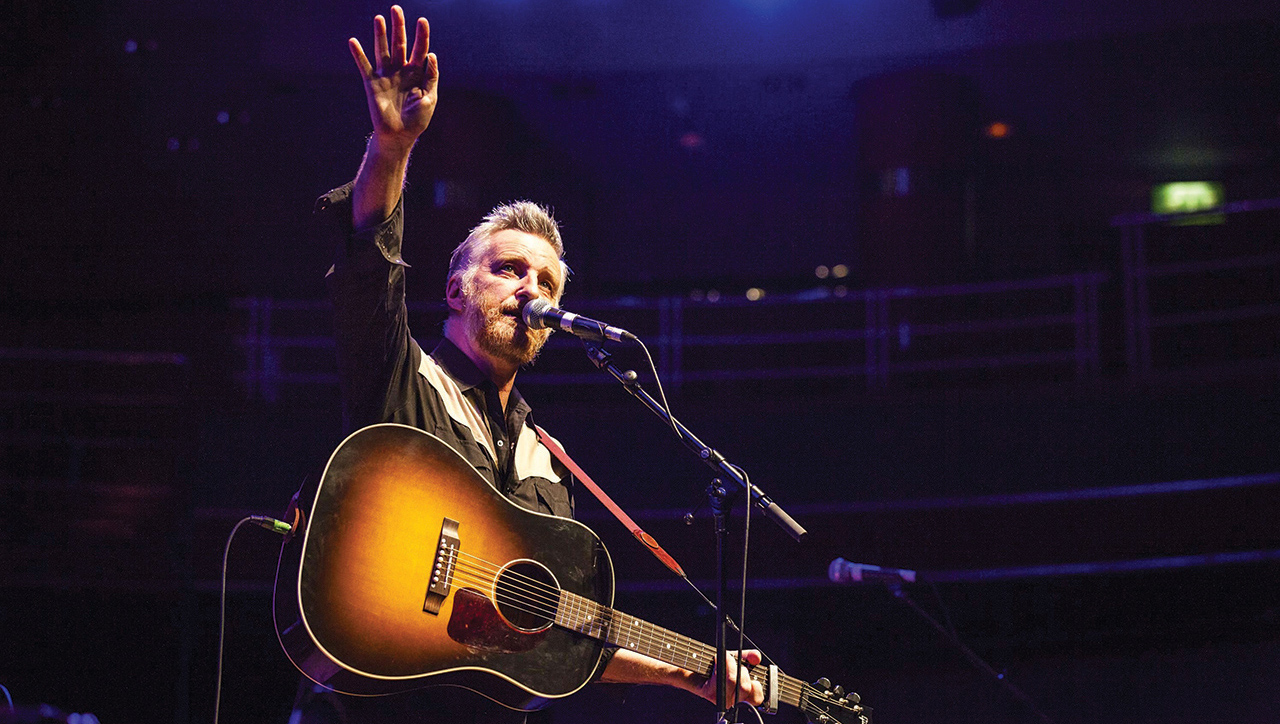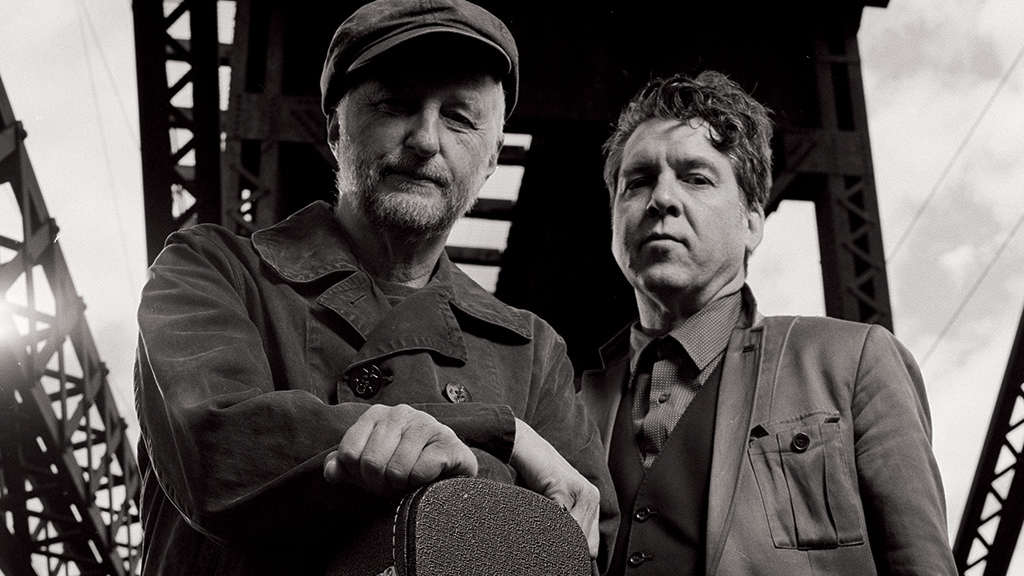The hiss of steam; the lonesome whistle; the clatter of steel in the night. Nothing resonates on a psychological level quite like a train. Especially in America, where the railroad remains one of the most enduring metaphors in popular song. This notion plugs directly into Shine A Light: Field Recordings From The Great American Railroad, a collaboration between our own Billy Bragg and American singer-songwriter Joe Henry.
“After the idea of the Old West, the railroad comes pretty close in holding a kind of magical position in the American consciousness,” Bragg says. “Nobody ever writes a song that goes: ‘I heard that lonesome car horn…’ There’s something about the train that goes much deeper, emotionally. The train was such a catalyst for change in human existence, particularly in the United States. They allowed people to imagine themselves over the horizon in another place.”
The idea behind Shine A Light was simple. Guitars in hand, Bragg and Henry travelled by train from Chicago to Los Angeles, recording a bunch of classic railroad songs along the way – in waiting rooms, on platforms, at the side of the tracks and occasionally on the train itself. In doing so they hoped to reconnect with the storied culture of American rail travel and the music that helped shape it.
The four-day journey, undertaken in March this year, ate up over 2,700 miles of track and saw the pair take on songs originally made famous by Hank Williams, Lead Belly, Jimmie Rodgers, Glen Campbell and the Carter Family, among others.
“I’m currently writing a book on how the guitar came to the front of British youth culture, which picks up from jazz into skiffle and rock’n’roll,” Bragg explains of his inspiration for the album. “And in the process of doing it I realised just how many train songs there are at the beginnings of British guitar music. People like Lonnie Donegan were basically playing Lead Belly’s repertoire, with a bit of Woody Guthrie thrown in, and that got me started.”

He and Henry first got to know each other during the 80s, when Bragg emerged as a voluble protest singer in the great tradition of Guthrie or Pete Seeger. Three years his junior, North Carolina-born Henry was then ploughing a furrow as a literate troubadour, prior to broadening his reach as a Grammy-winning producer for Bonnie Raitt, Elvis Costello, Solomon Burke, Allen Toussaint, Aaron Neville and others.
“Joe and I had wanted to work together for a long time,” says Bragg. “Our paths have crossed on a number of different levels over the years, and he produced my last album [2013’s Tooth & Nail].”
“Billy approached me about this concept, and I knew he’d been scheming on it for a while,” Henry adds. “It had to come from someone who doesn’t live in America but has a great love of the culture, with a very particular overview of our own mythology that some of us are too deep in the water to see very clearly. Billy is reminding us that not only is the railroad still active and relevant, but also the songs that grew out of it are still engageable vocabulary, they’re not museum pieces.”
It’s impossible to overstate the railway’s role in the dissemination of musical styles. Perhaps the most cogent example is the Rock Island Line, which became the first train link between Chicago and the Mississippi Delta when it was expanded in the 19th century. Flocks of southerners gradually headed north prior to the outbreak of World War I, looking for work in the steel mills and stockyards of the Windy City. So many musicians fetched up in Chicago over the next few decades – Big Bill Broonzy, Muddy Waters, Howlin’ Wolf, Willie Dixon, Elmore James, Bo Diddley and scores more – that the stretch of track became known as the main artery of “the blues route”.
- The 20 Greatest Chicago Blues Records
- Howlin' Wolf Vs The Doors - who sang Back Door Man best?
- Buyer's Guide: Muddy Waters
- Motor City Is Burning: How Unrest In Detroit Helped Build Motown
Shine A Light leads off with Rock Island Line, a song popularised by Lonnie Donegan in 1955, which kick‑started the skiffle craze and influenced The Beatles, the Stones and almost every other British band of the beat boom.
“Most people in the UK are familiar with that version, which is actually Lead Belly’s,” says Bragg. “And Lead Belly originally heard it being sung in Cummins Prison Farm in southern Arkansas. If you listen to the recording that was made when he was there with [musicologist and folklorist] John Lomax in the 1930s, the group sing it as a call-and-response song. It’s more like a work song than the way Donegan and Lead Belly sing it. Joe and I took our version right back to that.”
The B-side of Donegan’s Rock Island Line was John Henry, another classic that Bragg and Henry took on. A folkloric rail hand whose job was to hammer a steel drill into rock, John Henry is said to have outperformed his mechanised equivalent, only to die in the process. Shine A Light’s rendition celebrates both his heroic deeds and the sacrifices that people made in the opening up of the American interior.
Attempting to cover such staples of the American songbook threw up its own problems: namely, how to invest them with fresh life. One of the album’s best moments is a version of The L&N Don’t Stop Here Anymore, originally recorded by Kentucky folkstress Jean Ritchie and later lionised by Johnny Cash.
“That song became a template for the whole album,” says Henry. “The goal was to do something that feels authentically like a piece of documentation, yet still feels robust and musically inviting. That was the challenge: how to crack the code to where it’s an evolving thing. It’s like trying to rob a house – you’re looking for a door or window that’s left open. You’ve got to find whatever allows you access.”
The L&N Don’t Stop Here Anymore was recorded in an acoustic alcove above the northern staircase of the Great Hall at Chicago’s Union Station – the setting for the classic shoot‑out scene in Brian de Palma’s gangster film The Untouchables. This set the pattern for the project itself. The duo, joined by recording engineer Ryan Freeland and a two-man film crew, set up their equipment wherever and whenever time allowed during brief stops on the trip.
Bragg and Henry’s musical travelogue also carried a certain degree of serendipity. One such moment came in Texas, just prior to recording Waiting For A Train, originally cut in 1928 by country music’s first great superstar, Jimmie Rodgers.
“We did that in the Gunter Hotel in San Antonio, where Robert Johnson did his first recordings in 1936, in room 414,” Bragg explains. “Our train was four hours late so we didn’t arrive there until two in the morning. And they happened to give me room 414. I was like, ‘Shit!’ The next morning I said to Joe over breakfast: ‘I’ve got the Robert Johnson room – we’ve got to do some recording in there.’ The next song up was Waiting For A Train, and it was only when I got back to England that I discovered Jimmie Rodgers had a permanent suite in the hotel for the last five years of his life.”
Bragg and Henry will be touring Shine A Light this November, and they hope the project will reignite interest in one of the most iconic forms of transport.
“The railroad has lost its viability and its romance for most Americans,” Bragg laments. “Some of the waiting rooms we played in were obviously built for thousands of people, whereas now they’re dealing with tens of passengers every day. I remember the first time I ever went to the United States, driving along the freeway and seeing one of those six-mile trains go by. It was incredible. You see them on the far horizon, or you might be lying on your bed in some small college town at night and hear the whistle blow. It’s so evocative. It’s one of the few things from the nineteenth century in America that still functions.”

